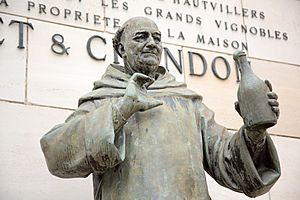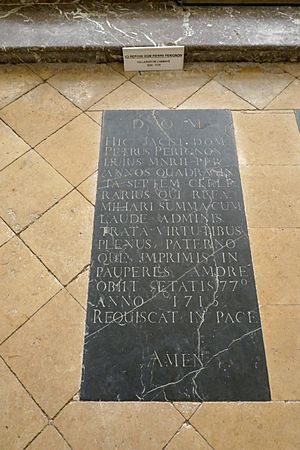Dom Pérignon (monk) facts for kids
Pierre Pérignon (born December 1638 – died 14 September 1715) was a French Benedictine monk. He made important improvements to how Champagne wine was made. Back then, most wines from the Champagne region were still (not bubbly) and red.
Many popular stories wrongly say he invented sparkling Champagne. But sparkling Champagne didn't become popular until the mid-1800s. The famous Champagne brand Dom Pérignon, made by Moët & Chandon, is named after him. The old monastery where he lived and worked is now owned by this winery.
Dom Pérignon lived at the same time as King Louis XIV of France (1638–1715).
Life Story
Pérignon was born in December 1638 in Sainte-Menehould, a town in the old French region of Champagne. He was baptized on January 5, 1639. He was the youngest of seven children. His mother passed away the summer after he was born. His father's family owned several vineyards in the area.
As a child, Pérignon joined a boys' choir school at the Benedictine Abbey of Moiremont. He studied there until 1651. Then, he went to study at a Jesuit college in Châlons-sur-Marne.
When he was 17, he became a Benedictine monk. He joined the Abbey of Saint-Vanne near Verdun. This abbey was part of a movement to improve monastic life. He followed a strict routine of prayer, study, and work. In 1668, he moved to the Abbaye Saint-Pierre d’Hautvillers. He worked there as the cellarer for the rest of his life. A cellarer is in charge of the monastery's food and drink supplies, especially the wine.
Under his care, the abbey grew. Its vineyards doubled in size. He worked hard to make their wine better.
When Pérignon died in 1715, he was buried in a special part of the abbey cemetery. This area was usually only for important abbots, showing how much he was respected. That cemetery is now owned by the local town.
The most famous statue of Dom Pérignon is at the entrance of Moët & Chandon's main office in Épernay. In 2022, a new, very artistic statue was put up in Hautvillers. This bronze statue includes a large champagne bottle and grapevines. Two cellar keys hang from his belt, representing the symbol of the village.
How He Changed Champagne Making
In Dom Pérignon's time, making wine was tricky. Sometimes, the fermentation process (where sugar turns into alcohol) would stop in the autumn. If the wine was bottled then, it could become a problem. When spring came and the weather got warmer, the yeast would wake up. It would start making carbon dioxide gas. This gas would build up pressure inside the bottles. At best, the corks would pop out. At worst, the bottles would explode! This was dangerous for workers and could ruin a whole year's wine.
Dom Pérignon tried to stop this re-fermentation from happening. However, he did introduce some things that are still important for Champagne today. He was especially good at blending grapes from many different vineyards.
In 1718, a priest named Canon Godinot wrote down some winemaking rules. He said these rules came from Dom Pérignon. One rule was that good wine should only be made from Pinot noir grapes. Pérignon didn't like white grapes because they tended to re-ferment.
Other rules Godinot mentioned included Pérignon's advice to trim vines short, no taller than three feet. This made them produce a smaller, better crop. Grapes should be picked in cool, damp weather, like early morning. Great care was taken to make sure grapes didn't get bruised or broken. Rotten or too-large grapes were thrown out. Pérignon also didn't allow grapes to be stomped on. He preferred using several presses to gently squeeze the juice from the grapes and skins.
Pérignon also believed in making wine using only natural methods. He didn't like adding other substances to the wine.
Common Myths About Him
There's a famous quote often said to be from Dom Pérignon: "Come quickly, I am tasting the stars!" This is supposedly what he said when he first tasted sparkling champagne. But this quote actually first appeared in a print advertisement much later, in the late 1800s.
Many of the wrong ideas about Dom Pérignon came from another monk at the Abbey of Hautvillers, Dom Groussard. In 1821, Groussard claimed that Dom Pérignon "invented" Champagne. He also told other exaggerated stories about the abbey. He did this to make the church seem more important and famous.
Groussard's stories did more than just make the church look good. They also helped sell Champagne around the year 1900. A group called the Syndicat du Commerce used the myth to promote Champagne and its region. In 1896, they published a pamphlet that praised Pérignon as the inventor of Champagne. This myth helped protect Champagne made in Marne as the original sparkling wine. It also helped to make other sparkling wines seem like copies. The myth also changed how people saw Champagne. It went from being a drink for rich people to one made by a monk's hard work.
The myths that Pérignon was the first to use corks and that he could name a vineyard just by tasting a single grape probably came from Groussard's stories too.
Before blending grapes, Pérignon would taste them without knowing which vineyard they came from. This was so his opinion wouldn't be influenced. Because of this, some people mistakenly thought Dom Pérignon was blind. He wasn't blind; he just tasted "blind" to be fair.
Also, contrary to popular belief, Dom Pérignon did not introduce the idea of blending wines in Champagne. Instead, he started the method of blending the grapes before they were pressed.
See also
 In Spanish: Pierre Pérignon para niños
In Spanish: Pierre Pérignon para niños
- History of Champagne
- List of wine personalities



